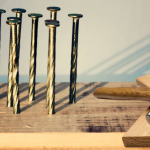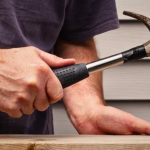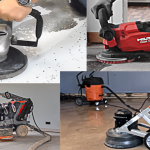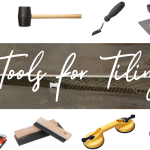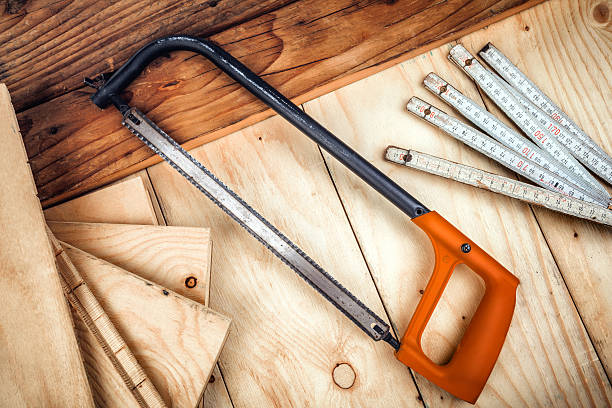
HACKSAW:IT’S PARTS, TYPES, FRAME AND BLADES
What is Hacksaw?
A hacksaw is a fine-toothed saw that was initially meant to cut metal, whereas a bow saw is the wood-cutting counterpart. Hacksaws are hand tools that are used to cut metal that is too thick or hard for cutters to cut.
A hacksaw consists of two main elements:
- A frame with a handle
- A blade
Hacksaw blades are often categorized as flexible or hardened, with differences in coarseness, tooth pitch, and length to consider while selecting the right hacksaw for the task.
Hacksaw Design
Most hacksaws are handsaws with a C-shaped walking frame to keep the blade tensioned. Such hacksaws typically have a handle, usually a pistol grip, with pins for connecting a narrow disposable blade. The frames may also be adjustable to accommodate blades of varying diameters. A screw or other device can be used to tension the thin blade.
The blade can be installed on the teeth with its face facing towards or away from the holder, which is used in the cutting action, whether on the push or pull stroke, in most frame saws and hacksaws. The blades are normally arranged to face forward, and the work is supported in a bench vice while cutting vertically downwards.
Parts of a Hacksaw
- Hacksaw frame
- Hacksaw blade
- Adjustable wing nut
- Stud
- Adjustable screw
- Handle
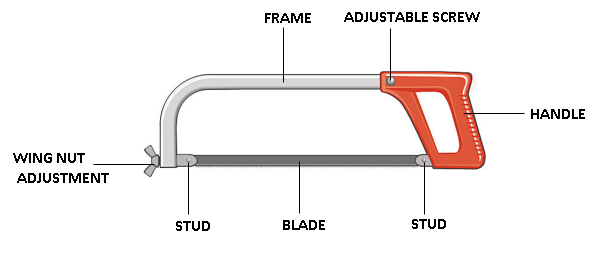
Hacksaw Frame
It has the same form as the letter “C.” A handle is attached to one end of these arms, while a pin is attached to the other. A hacksaw blade is initially installed on these pins, then tightened with a flying nut or wing nut as needed. Hacksaw frames are primarily divided into two types:
Types of Hacksaw Frame
- Fixed Hacksaw Frame
- Adjustable Hacksaw Frame
1) Fixed Hacksaw Frame
A portion of the flat iron strip is bent at the proper angle to form this type of hacksaw frame. In this type of frame, hacksaw blades of a given size cannot be set, neither short nor long. There are 2 types of handles used here:
- Straight handle
- Pistol handle

2) Adjustable Hacksaw Frame
The structure of an adjustable hacksaw frame differs slightly from that of a fixed frame. The frame of the adjustable hacksaw is made up of 2 sections. These components may be changed to various lengths. As a result, several types of big and small hacksaw blades may be utilized in this hacksaw.
There are enough pins and channels to allow you to pull, adjust, and set them. In this hacksaw, the following handles are used:
- Straight handle
- Pistol-type handle
- Tubular type handle
- Flexible Blades
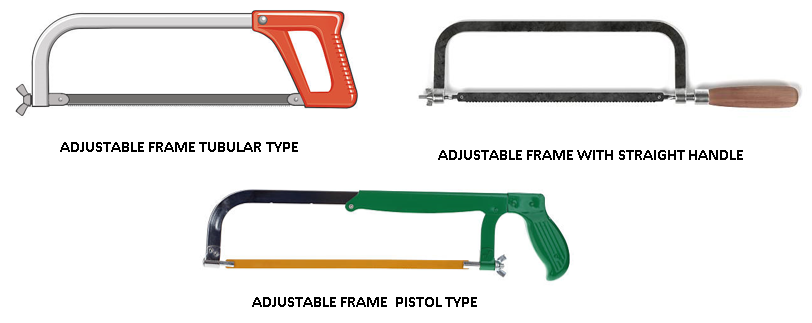
Hacksaw Blade
Hacksaw blade lengths range from 10 to 12 inches (250 to 300 mm). Blades can range in size from 6 inches up to 12 inches (150 mm). Powered hacksaws often employ large blades of varying diameters, whereas compact machines employ the same hand blades for small jobs.
A hand blade’s tooth pitch can range from 14 to 32 TPI (teeth per inch), whereas a big power hacksaw blade’s tooth pitch can be as low as 3 TPI. The thickness of the material to be cut determines which blade is used, with a minimum of three teeth in the material. Because hacksaw teeth are so tiny, they are positioned in a “wave” set. Other saws are put from side to side to provide clearance or kerf while sawing. The set of a hacksaw varies, typically from tooth to tooth in a curve, rather than alternate teeth set left and right.
ALSO READ : TYPES OF HAND SAW AND THEIR USES.
Types of Hacksaw Blades
The main types of hacksaw blades are as follows:
- Medium Grade Hacksaw Blade
- Course Grade Hacksaw Blade
- Fine Grade Hacksaw Blade
- All Hard Blade
- Superfine Grade Hacksaw Blade
1. Medium Grade Hacksaw Blade
This is used to cut metals such as aluminum, brass, high carbon steel, cast iron, tool steel, and so on. This hacksaw blade cuts at a rate of 20 to 24 TPI (teeth per inch).
2. Course Grade Hacksaw Blade
This types is used to trim the width of mild steel, copper, aluminum, and brass, among other materials. It has 14 to 18 teeth per inch.
3. Fine Grade Hacksaw Blade
This is mostly used to cut thinner pipes, sheets, tubes, and so on. These blades have between 24 and 30 dents per inch.
4. All Hard Blade
The nature of these blades is that they are hard and tempered, with the exception of the ends, which contain holes, making them slightly weak. These are used to cut cast iron, mold iron, and other metals.
5. Superfine Grade Hacksaw Blade
An extremely thin type of hacksaw blade is used to cut exceptionally hard metals and light metal sheets. There are 30 to 32 dents per inch on these blades.
All of the hacksaw blades in the various categories stated here have teeth on one or both sides. These blades are reinforced in two different ways, depending on their properties.
6. Flexible Blade
Only the cutting teeth and adjacent parts of this type of blade are hardened and tempered. This approach, on the other hand, becomes flexible and has a minimal chance of becoming brittle and breaking in the case of a shock. These blades are used to cut thin sheets, pipelines, curves, and other materials.
SETTING OF TEETH
The hacksaw blade’s teeth are also bent to the left or right, much like on a regular saw for cutting wood. The setting of teeth refers to the bending of teeth. The hacksaw blade cuts a slot in the metal that is somewhat thicker than the blade with this tooth arrangement.
As a result of this slot, the blade does not become caught while in use. If the blade is not properly placed, it may become trapped in the metal and break. Teeth in a blade can be arranged in three ways.
1.Single Configuration or Regular
One tooth is bent to the left, the next to the right, and the fifth tooth is left straight in this style of arrangement. This tooth helps in clearing the slot of metal particles.
2. Double Alternate
Two teeth are rotated to the right and two to the left in this configuration, with the dent between them left straight to remove metal particles from the slot.
3. Wave Setting, or Zig-Zag
A few teeth are bent to the right and others to the left in this style of arrangement. There seems to be a wave as a result of this. Fine and superfine blades are subjected to this type of setting.

